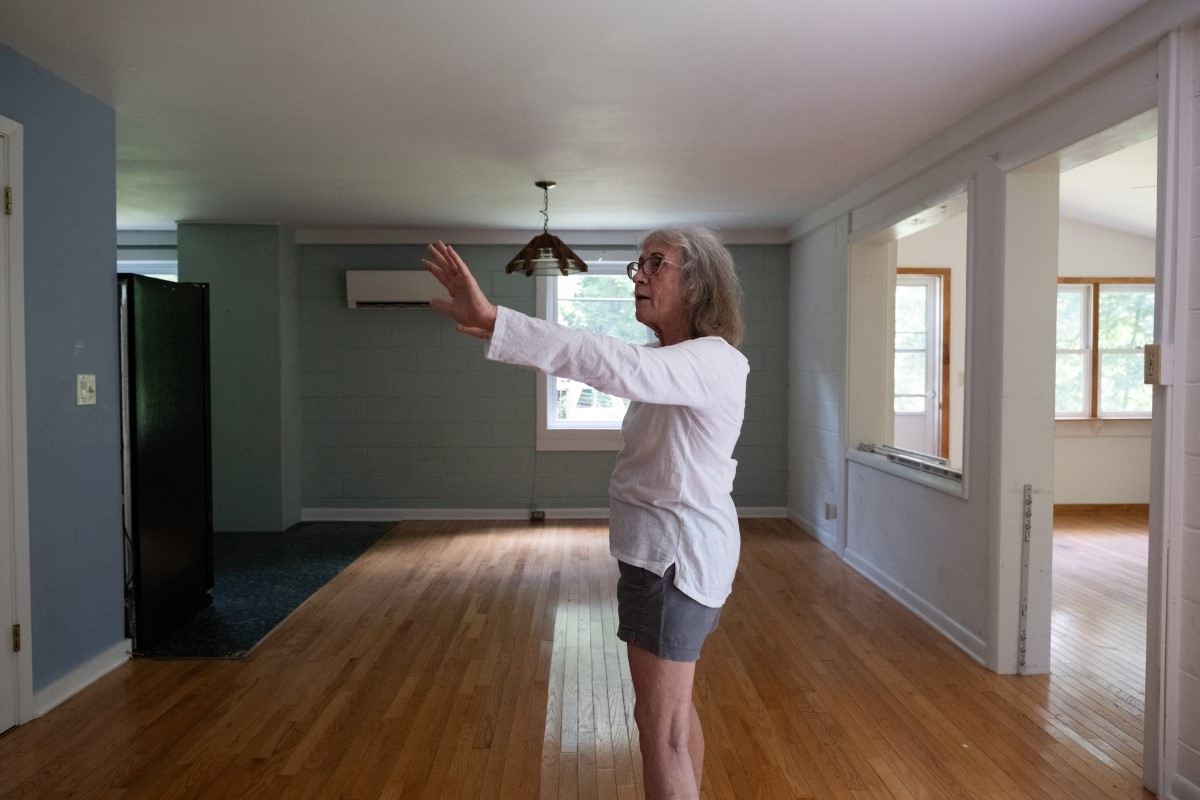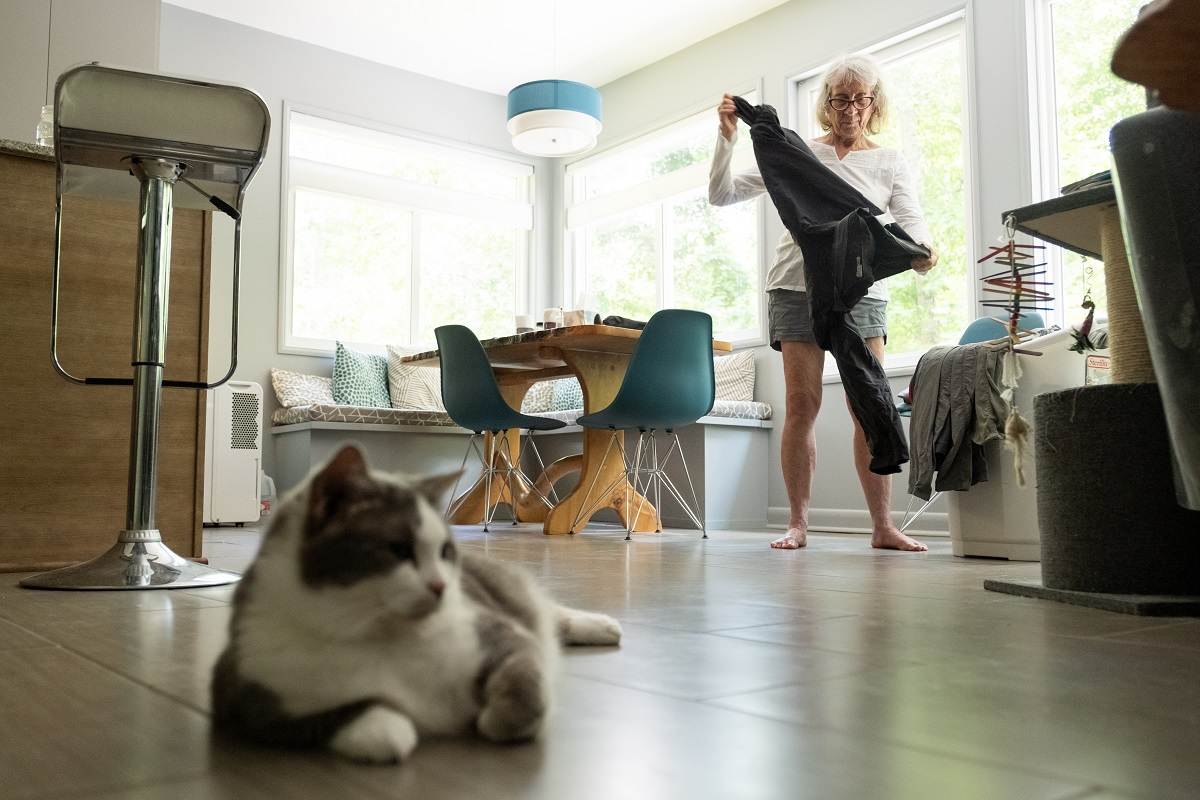
Cynthia Holzapfel describes the downstairs unit of her home.
16:24 JST, June 20, 2024

The entrance and welcome center to the Farm community is seen in Summertown.
Cynthia Holzapfel, 76, knows what it’s like to share a home with someone else – or even 30 others.
As one of the early residents of the Farm, a 1970s-era commune in Summertown, Tenn., Holzapfel lived under the same roof with multiple couples and more than a dozen children in a five-bedroom house where everything from the laundry room to meals was shared.
“It was a constant party,” she says. “It was like having all your cousins move in with you.”
The Farm is no longer a commune, although the land is still owned collectively by its residents. Yet one thing never changed for Holzapfel: housemates. Over the last 20 years, she has rented her basement to seven families.
Holzapfel is among the growing number of baby boomers, the 76 million people born in the United States from 1946 to 1964, living with intergenerational housemates. And they just may be part of the solution to America’s grinding housing crisis.
Baby-boomer empty nesters now own more large homes in major cities than millennial families – and show few signs of moving out. Record prices and scarce inventory appear to have frozen everyone in place.
Several generations living under one roof would help ease the housing crunch and the loneliness epidemic affecting half of U.S. adults. It would also cut global warming emissions. Denser living is almost always greener: fewer homes, less energy and more efficiency overall. Freeing up room in boomers’ homes could also bring young people and suburban families back to communities near jobs and schools, eliminating polluting commutes.
“We’ve had a really delightful time with almost everyone that’s come through here,” says Holzapfel, adding some of their youngest housemates have become like grandchildren. “Each older couple can strike the right balance of who they want to have around. Everyone can find what works for them.”
“Boommates” have been booming for years, according to census data. Here’s why you might want to join them.
The housing crunch
Intergenerational living was once common in American cities. Everyone from families of modest means to the upper-class rented out rooms or entire floors. These boardinghouses served as many as half of 19th-century urban residents. Poet Walt Whitman, who lived in boardinghouses in his early teens, described them as the country’s melting pot in 1842. “Married men and single men, old men and pretty girls; milliners and masons; cobblers, colonels, and counter-jumpers; tailors and teachers; lieutenants, loafers, ladies, lackbrains, and lawyers; printers and parsons-‘black spirits and white, blue spirits and gay’-all ‘go out to board,’” reports the Boston Globe.
Yet many cities have essentially outlawed new duplexes and townhouses built to accommodate multiple generations under one roof. Exclusionary zoning laws restrict 70 percent of all residential land to single-family homes fueling a dire affordability crisis, according to a 2024 report by the White House Council of Economic Advisers.
Last year, three-quarters of the country’s housing markets were considered unaffordable, according to Attom, a real estate data company. Homeowners are spending about 35 percent of their income on housing costs on average, far above the 28 percent benchmark to be considered affordable.
Bigger homes also are scarce because empty nesters are still in them, says Jennifer Molinsky of Harvard University’s Joint Center for Housing Studies. Baby-boomer households without children living at home own an estimated 28 percent of the nation’s large houses with three or more bedrooms compared with just 14 percent of millennial households with children, despite this generation outnumbering its boomer counterparts.
There are good reasons baby boomers are holding on to their houses: Older homeowners typically enjoy rock-bottom mortgage rates, and the vast majority prefer to grow old in their own homes. Even for those willing to move, few options to downsize exist because of the scarcity of affordable, “missing-middle” housing units in their communities.
That means millions of bedrooms sit empty. The real estate company Trulia estimated in 2017 that 3.6 million vacant bedrooms in baby-boomer households could be rented out in the 100 largest U.S. metro areas.
The rise of the boommate
The housing crunch prompted Nancy, a retired professor of astronomy who lives in a Boston suburb, to open up her 1889, five-bedroom house to renters.
“I started renting in 2016, and never looked back,” she says, asking her last name not be used for privacy. “Even if I had plenty of money, I don’t think I would want to live here by myself.”
Typically, she has an older housemate and a younger one, a graduate student from nearby Boston College placed by the school’s housing office. Each person has their own bedroom and private bathroom, and the trio share a kitchen and common space, occasional meals or even road trips. “All have been great people,” she adds.
Like Nancy, some over the age of 65 now live with unrelated housemates or roommates, according to estimates based on 2022 U.S. census data by Molinsky. About 50 percent of them are younger adults.
There are now a variety of services that help people find a boommate. HomeShare Online (formerly Silvernest) offers nationwide matching with free and paid tiers. Nesterly finds graduate students in college towns willing to help with household chores for discounted rent. An online search will probably turn up a home-sharing agency near you, often at no cost. The National Shared Housing Resource Center lists about 50 nonprofits.
For those who can afford it, carving a duplex, private suite or accessory dwelling unit (ADU) out of an existing home can offer more privacy and revenue. Some companies even pay homeowners for this. California start-up BuildCasa offers up to $400,000 to subdivide your lot, and build a backyard ADU or duplex it owns. If you want your own, BuildCasa can advise you on the process of creating a second property for them to rent or sell.
What makes a successful boommate match?

Cynthia Holzapfel folds laundry in her home, in Summertown, Tenn.
Anyone can be a boommate. Professional services, trusted friends or institutions, such as local universities, can be a source of vetted tenants. Laying out expectations up front and in writing, along with clear communication, avoids misunderstandings or conflicts, especially around common areas such as the laundry room or kitchen. Finding the right terms takes a little practice.
Many services recommend background and credit checks, and provide home-sharing agreements refined over many matches.
Luke Barnesmoore of Front Porch, a housing nonprofit, says home-sharing is now an essential social service for seniors and workers unable to afford a place to live. “We’re now in the space of homeless prevention,” he said. Americans 50 and older are the fastest-growing age group experiencing homelessness, according to the U.S. Department of Health and Human Services, accounting for about half of the total homeless population.
Over the last few years, the nonprofit has made more intergenerational matches. Despite some participants’ hesitation about the age gap, Barnesmoore says a successful match is less about age than values. Front Porch says it hasn’t had to end a match in at least four years.
“Social dynamics are often pretty similar,” he says. “Humans are humans. We have so much more in common than the generational difference might imply.”
Serena Kachinsky, 44, had her doubts about giving up her own space. “Even in college, I was like, ‘I don’t want roommates,’” she says. “Sharing space is hard.”
But after enduring California’s brutal housing market for more than a decade, she and her husband decided they needed to make a change. With one child, and another on the way, they moved to Tennessee where her husband grew up.
They moved into Holzapfel’s basement in 2020, just before the pandemic. The Farm offered a tightknit community, a new life and the chance to expand their family beyond what they could afford in the Bay Area, among the most expensive places to live in the world.
The experience was like gaining another family, she said. Holzapfel and her husband Bob helped out with Kachinsky’s two children. The families shared time in the yard and held a weekly pizza night. Many times, Kachinsky said, the Holzapfels offered invaluable advice drawn from decades of experience, something she described as the most valuable part of the experience.
“It was just like having a set of grandparents around,” she says. “One of my son’s first words was ‘Bob.’ We were that closely intertwangled.”
Kachinsky’s family eventually outgrew Holzapfel’s basement after the arrival of their third child. They now live down the street, but still visit.
Holzapfel says she plans to rent her basement again once the couple finishes a few home repairs. They see their role as welcoming young families to the Farm, and getting them started in their next phase of life.
“We’re a launching pad,” she says.
"News Services" POPULAR ARTICLE
-

American Playwright Jeremy O. Harris Arrested in Japan on Alleged Drug Smuggling
-

Japan’s Nikkei Stock Average as JGB Yields, Yen Rise on Rate-Hike Bets
-

Japan’s Nikkei Stock Average Licks Wounds after Selloff Sparked by BOJ Hike Bets (UPDATE 1)
-

Japanese Bond Yields Zoom, Stocks Slide as Rate Hike Looms
-

Japan’s Nikkei Stock Average Buoyed by Stable Yen; SoftBank’s Slide Caps Gains (UPDATE 1)
JN ACCESS RANKING
-

Keidanren Chairman Yoshinobu Tsutsui Visits Kashiwazaki-Kariwa Nuclear Power Plant; Inspects New Emergency Safety System
-

Imports of Rare Earths from China Facing Delays, May Be Caused by Deterioration of Japan-China Relations
-

University of Tokyo Professor Discusses Japanese Economic Security in Interview Ahead of Forum
-

Japan Pulls out of Vietnam Nuclear Project, Complicating Hanoi’s Power Plans
-

Govt Aims to Expand NISA Program Lineup, Abolish Age Restriction



















